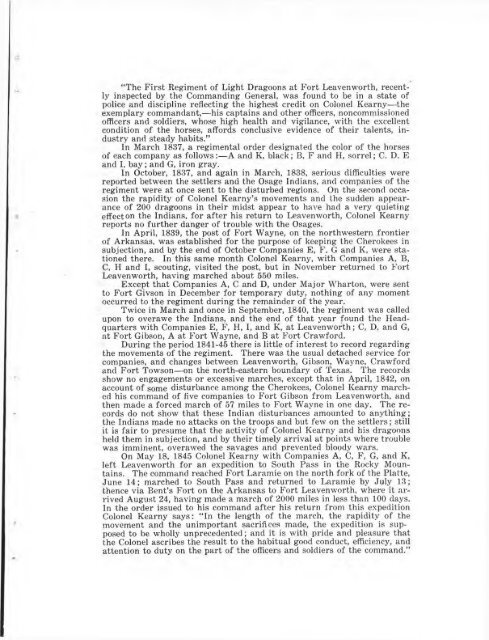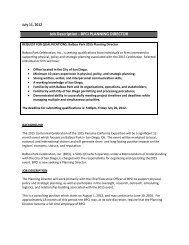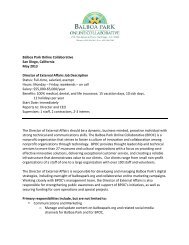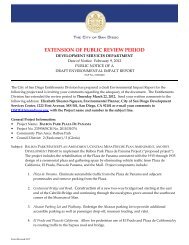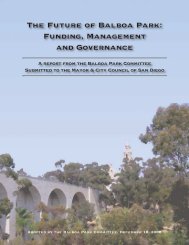Army and Navy Review 1915 Panama-California Edition - Balboa Park
Army and Navy Review 1915 Panama-California Edition - Balboa Park
Army and Navy Review 1915 Panama-California Edition - Balboa Park
Create successful ePaper yourself
Turn your PDF publications into a flip-book with our unique Google optimized e-Paper software.
“The First Regiment of Light Dragoons at Fort Leavenworth, recently<br />
inspected by the Comm<strong>and</strong>ing General, was found to be in a state of<br />
police <strong>and</strong> discipline reflecting the highest credit on Colonel Kearny—the<br />
exemplary comm<strong>and</strong>ant,— his captains <strong>and</strong> other officers, noncommissioned<br />
officers <strong>and</strong> soldiers, whose high health <strong>and</strong> vigilance, with the excellent<br />
condition of the horses, affords conclusive evidence of their talents, industry<br />
<strong>and</strong> steady habits.”<br />
In March 1837, a regimental order designated the color of the horses<br />
of each company as follows:—A <strong>and</strong> K, black; B, F <strong>and</strong> H, sorrel; C. D. E<br />
<strong>and</strong> I, bay; <strong>and</strong> G, iron gi-ay.<br />
In October, 1837, <strong>and</strong> again in March, 1838, serious difficulties were<br />
reported between the settlers <strong>and</strong> the Osage Indians, <strong>and</strong> companies of the<br />
regiment were at once sent to the disturbed regions. On the second occasion<br />
the rapidity of Colonel Kearny’s movements <strong>and</strong> the sudden appearance<br />
of 200 dragoons in their midst appear to have had a very quieting<br />
effect on the Indians, for after his return to Leavenworth, Colonel Kearny<br />
reports no further danger of trouble with the Osages.<br />
In April, 1839, the post of Fort Wayne, on the northwestern frontier<br />
of Arkansas, was established for the purpose of keeping the Cherokees in<br />
subjection, <strong>and</strong> by the end of October Companies E, F. G <strong>and</strong> K, were stationed<br />
there. In this same month Colonel Kearny, with Companies A, B,<br />
C, H <strong>and</strong> I, scouting, visited the post, but in November returned to Fort<br />
Leavenworth, having marched about 550 miles.<br />
Except that Companies A, C <strong>and</strong> D, under Major Wharton, were sent<br />
to Fort Givson in December for temporary duty, nothing of any moment<br />
occurred to the regiment during the remainder of the year.<br />
Twice in March <strong>and</strong> once in September, 1840, the regiment was called<br />
upon to overawe the Indians, <strong>and</strong> the end of that year found the Headquarters<br />
with Companies E, F, H, I, <strong>and</strong> K, at Leavenworth; C, D, <strong>and</strong> G,<br />
at Fort Gibson, A at Fort Wayne, <strong>and</strong> B at Fort Crawford.<br />
During the period 1841-45 there is little of interest to record regarding<br />
the movements of the regiment. There was the usual detached service for<br />
companies, <strong>and</strong> changes between Leavenworth, Gibson, Wayne, Crawford<br />
<strong>and</strong> Fort Towson— on the north-eastern boundary of Texas. The records<br />
show no engagements or excessive marches, except that in April, 1842, on<br />
account of some disturbance among the Cherokees, Colonel Kearny marched<br />
his comm<strong>and</strong> of five companies to Fort Gibson from Leavenworth, <strong>and</strong><br />
then made a forced march of 57 miles to Fort Wayne in one day. The records<br />
do not show that these Indian disturbances amounted to anything;<br />
the Indians made no attacks on the troops <strong>and</strong> but few on the settlers; still<br />
it is fair to presume that the activity of Colonel Kearny <strong>and</strong> his dragoons<br />
held them in subjection, <strong>and</strong> by their timely arrival at points where trouble<br />
was imminent, overawed the savages <strong>and</strong> prevented bloody wars.<br />
On May 18, 1845 Colonel Kearny with Companies A, C, F, G, <strong>and</strong> K,<br />
left Leavenworth for an expedition to South Pass in the Rocky Mountains.<br />
The comm<strong>and</strong> reached Fort Laramie on the north fork of the Platte,<br />
June 14; marched to South Pass <strong>and</strong> returned to Laramie by July 13;<br />
thence via Bent’s Fort on the Arkansas to Fort Leavenworth, where it arrived<br />
August 24, having made a march of 2000 miles in less than 100 days.<br />
In the order issued to his comm<strong>and</strong> after his return from this expedition<br />
Colonel Kearny says: “In the length of the march, the rapidity of the<br />
movement <strong>and</strong> the unimportant sacrifices made, the expedition is supposed<br />
to be wholly unprecedented; <strong>and</strong> it is with pride <strong>and</strong> pleasure that<br />
the Colonel ascribes the result to the habitual good conduct, efficiency, <strong>and</strong><br />
attention to duty on the part of the officers <strong>and</strong> soldiers of the comm<strong>and</strong>.”


